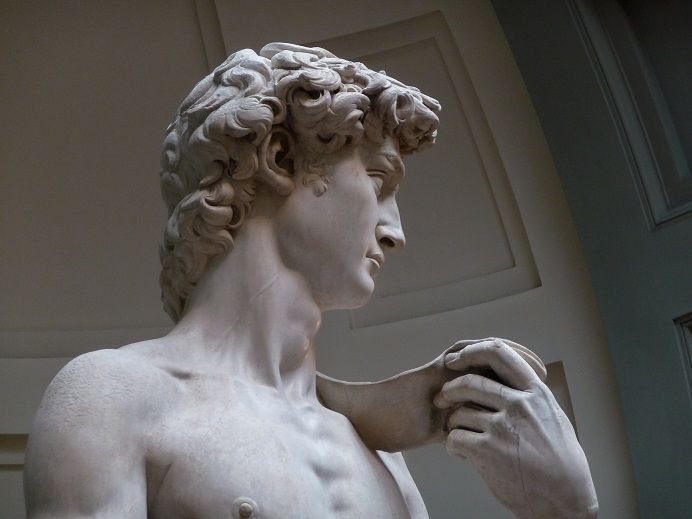
What do David and the Mona Lisa have in common? They're both Renaissance masterpieces, and they've both become so famous that you might be slightly sick of them. Even if you've never set foot in the Accademia or the Louvre, the faces of David and the Mona Lisa are probably as familiar - or even more familiar - than the faces of some of your friends.
David is everywhere. In the five hundred years of his existence he's been celebrated, imitated, parodied, and printed on t-shirts, socks and novelty kitchen aprons. He's transcended his original status as a work of art to become a popular icon.
Visiting Florence without seeing David is like visiting Rome and giving the Colosseum a miss. You can't not see it. The Accademia attracts more than 3 million visitors a year, most of whom are only interested in one thing, judging by the comparatively empty galleries upstairs. Whether motivated by a love of art or a sense of sightseeing duty, everyone wants to see David.

Everyone except for me. I initially had no interest in seeing David. I wanted to visit the Uffizi, to see paintings by Caravaggio and Titian. I was interested in seeing other works by Michelangelo at the Accademia, as I'd seen pictures of his sculptures known as the Prisoners or Slaves, and I was intrigued by how modern they seemed. But David? I felt I'd already seen David a thousand times, and I didn't think there was anything to be gained from seeing the statue in person. I didn't know anyone who had been to Florence and rhapsodised about the experience of seeing David, even if they'd enjoyed their visit to the Accademia.
My brother was studying Renaissance art at university and had been given a lengthy list of places to visit in Florence. Of course the Accademia was there, printed in bold with two asterisks next to it, so we dutifully queued up and went in search of the most famous statue in the world.
Once inside the Accademia, my apathy was transformed into wonder. When I stood in front of David I was instantly struck by his sheer size. He's enormous - a larger than life superhero figure, somehow all the more beautiful for being out of proportion. Just like Botticelli's Venus, with her disproportionate body and impossible pose, David represents an idealised yet unrealistic human body. He's been sculpted with such skill that he seems physically perfect and lifelike, yet we're also aware that he's a 17 foot fantasy figure who could never exist in real life. Like all great works of art, David makes us marvel at the artist's skill, even as we become even more acutely aware of the gap between art and reality.
I spent a while slowly circling the statue, looking at it from every angle. I admired the incredible attention to detail - the curve of his muscles, the outlines of his veins - and thought about how incredible it was, that Michelangelo had created something so perfect out of a block of marble once considered to be too flawed to be used. I thought about Michelangelo, still only in his twenties, working on the sculpture in secrecy for two years before it was unveiled to the public in Piazza della Signoria. If we're amazed by David now, having seen his image countless times before we visit the Accademia, how much more amazing must David have been for the people of Florence in 1504?
Against all my expectations, seeing Michelangelo's David in person was a profound experience. But it could have easily been so different. I could have stood in front of the same statue, looking at it through the same eyes, and been totally unmoved. I'm sure that if I had visited the Accademia as a teenager, when I had little interest in art and knew nothing about Michelangelo, I would have found the experience underwhelming.

After a few years of living in Italy and developing an interest in Renaissance art, I finally saw David, and was impressed. Many people who visit the Accademia - people of all ages, nationalities, backgrounds and interests - are also impressed by David. However, I can imagine that there are plenty of other visitors who are underwhelmed. David is so famous that everyone, regardless of their interest in art, feels compelled to join the crowds admiring Michelangelo's masterpiece. Buy your ticket; spend 30 seconds looking at the statue; maybe take a photo or two; move on, unmoved.
Perhaps we should stop talking about David as a "must-see". Perhaps some people shouldn't see David at all - they might get more out of looking at other, less familiar works of art in Florence, away from the crowds, free from the pressure and expectation surrounding one of the most famous works of art in the world.
Over-hyping a work of art prevents us from seeing it for what it is - art. It's a bit like the case of the Japanese tourists who visit Paris and suffer from the crushing disappointment of discovering that Paris is not as beautiful or romantic as they'd been led to believe. It's not Paris's fault. Similarly, it's not David's fault that he's been praised to death over the past few centuries, gaining a reputation that's eclipsed the reality.
Don't see David because you feel that you "have to". Don't see David because everyone does. See David because you want to - because you're interested in seeing what one man was able to achieve with a flawed block of marble. Forget about the hyperbole, the tourist checklists and the novelty apron, and try to see David through your own eyes.
---
Alexandra Turney works for Through Eternity Tours, which offers tours of the Accademia.
